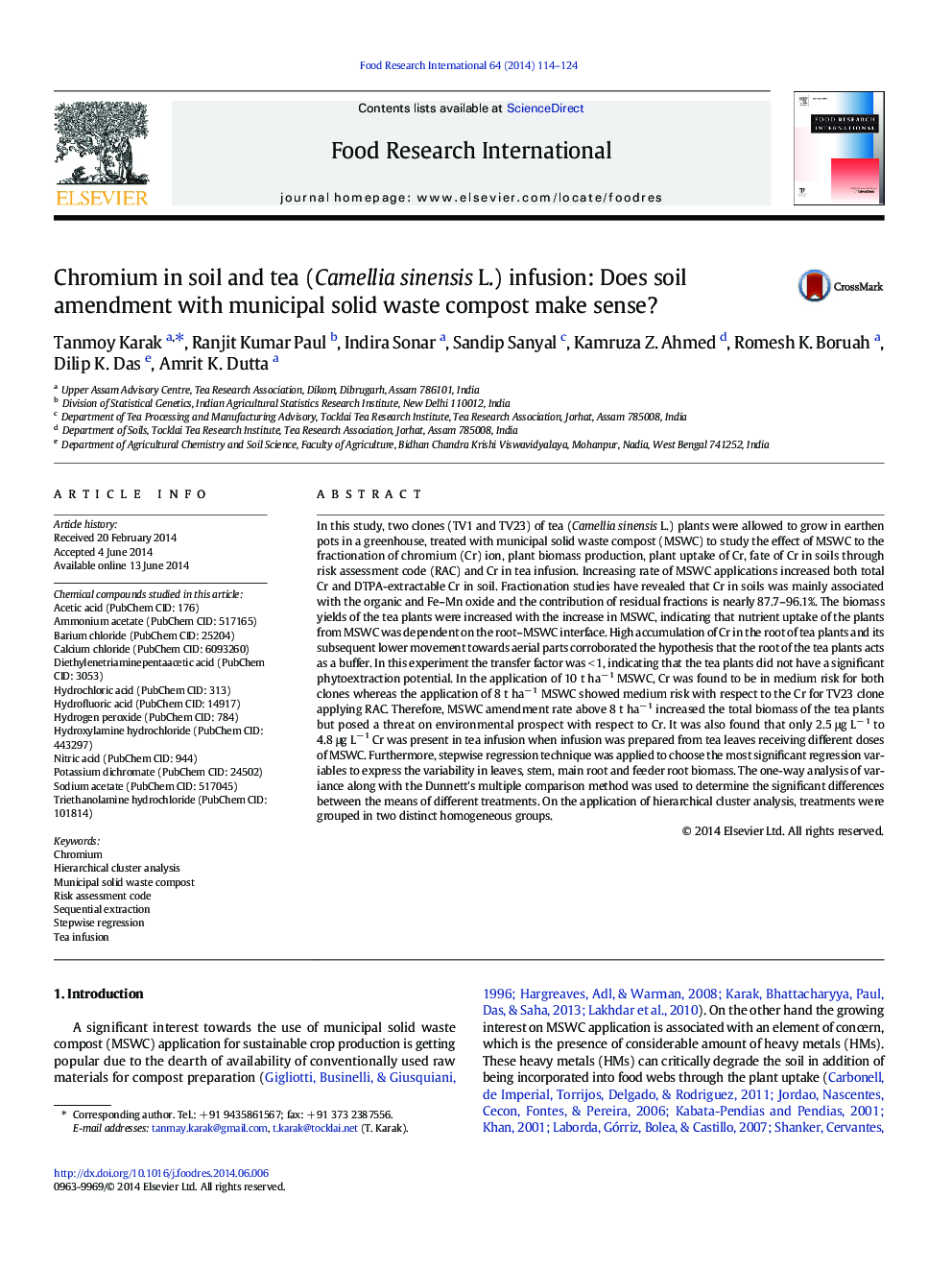| کد مقاله | کد نشریه | سال انتشار | مقاله انگلیسی | نسخه تمام متن |
|---|---|---|---|---|
| 6396557 | 1628481 | 2014 | 11 صفحه PDF | دانلود رایگان |
عنوان انگلیسی مقاله ISI
Chromium in soil and tea (Camellia sinensis L.) infusion: Does soil amendment with municipal solid waste compost make sense?
دانلود مقاله + سفارش ترجمه
دانلود مقاله ISI انگلیسی
رایگان برای ایرانیان
کلمات کلیدی
Ammonium acetate (PubChem CID: 517165)Hydroxylamine hydrochloride (PubChem CID: 443297)Sodium acetate (PubChem CID: 517045) - استات سدیم (PubChem CID: 517045)Sequential extraction - استخراج متوالیAcetic acid (PubChem CID: 176) - اسید استیک (PubChem CID: 176)Nitric acid (PubChem CID: 944) - اسید نیتریک (PubChem CID: 944)Hydrochloric acid (PubChem CID: 313) - اسید هیدروکلریک (PubChem CID: 313)Tea infusion - تزریق چایhierarchical clustering, Hierarchical cluster analysis - خوشه بندی سلسله مراتبی، تحلیل خوشه سلسله مراتبیStepwise regression - رگرسیون گام به گامHydrogen Peroxide (PubChem CID: 784) - پراکسید هیدروژن (PubChem CID: 784)Risk assessment code - کد ارزیابی ریسکChromium - کروم، فلزی سخت و خاکستری رنگ Municipal solid waste compost - کمپوست زباله های شهری
موضوعات مرتبط
علوم زیستی و بیوفناوری
علوم کشاورزی و بیولوژیک
دانش تغذیه
پیش نمایش صفحه اول مقاله

چکیده انگلیسی
In this study, two clones (TV1 and TV23) of tea (Camellia sinensis L.) plants were allowed to grow in earthen pots in a greenhouse, treated with municipal solid waste compost (MSWC) to study the effect of MSWC to the fractionation of chromium (Cr) ion, plant biomass production, plant uptake of Cr, fate of Cr in soils through risk assessment code (RAC) and Cr in tea infusion. Increasing rate of MSWC applications increased both total Cr and DTPA-extractable Cr in soil. Fractionation studies have revealed that Cr in soils was mainly associated with the organic and Fe-Mn oxide and the contribution of residual fractions is nearly 87.7-96.1%. The biomass yields of the tea plants were increased with the increase in MSWC, indicating that nutrient uptake of the plants from MSWC was dependent on the root-MSWC interface. High accumulation of Cr in the root of tea plants and its subsequent lower movement towards aerial parts corroborated the hypothesis that the root of the tea plants acts as a buffer. In this experiment the transfer factor was < 1, indicating that the tea plants did not have a significant phytoextraction potential. In the application of 10 t haâ 1 MSWC, Cr was found to be in medium risk for both clones whereas the application of 8 t haâ 1 MSWC showed medium risk with respect to the Cr for TV23 clone applying RAC. Therefore, MSWC amendment rate above 8 t haâ 1 increased the total biomass of the tea plants but posed a threat on environmental prospect with respect to Cr. It was also found that only 2.5 μg Lâ 1 to 4.8 μg Lâ 1 Cr was present in tea infusion when infusion was prepared from tea leaves receiving different doses of MSWC. Furthermore, stepwise regression technique was applied to choose the most significant regression variables to express the variability in leaves, stem, main root and feeder root biomass. The one-way analysis of variance along with the Dunnett's multiple comparison method was used to determine the significant differences between the means of different treatments. On the application of hierarchical cluster analysis, treatments were grouped in two distinct homogeneous groups.
ناشر
Database: Elsevier - ScienceDirect (ساینس دایرکت)
Journal: Food Research International - Volume 64, October 2014, Pages 114-124
Journal: Food Research International - Volume 64, October 2014, Pages 114-124
نویسندگان
Tanmoy Karak, Ranjit Kumar Paul, Indira Sonar, Sandip Sanyal, Kamruza Z. Ahmed, Romesh K. Boruah, Dilip K. Das, Amrit K. Dutta,